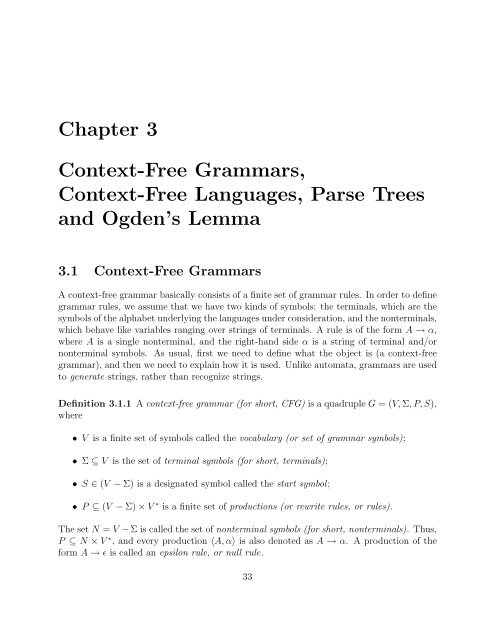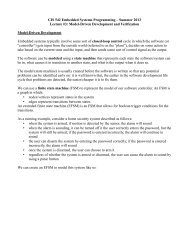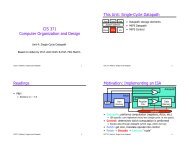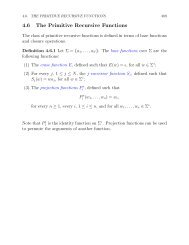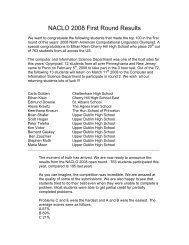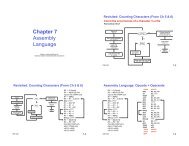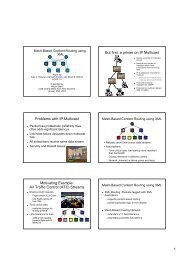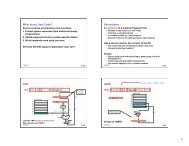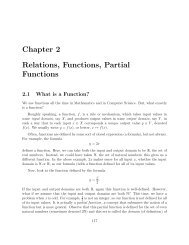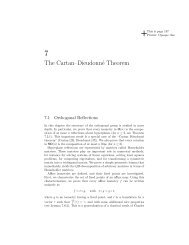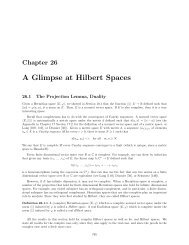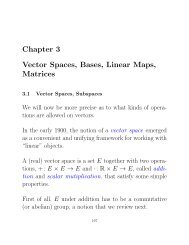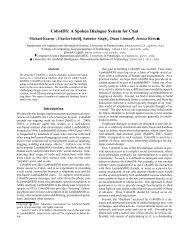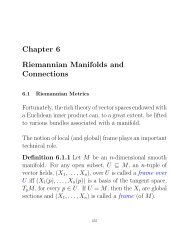Chapter 3 Context-Free Grammars, Context-Free Languages, Parse ...
Chapter 3 Context-Free Grammars, Context-Free Languages, Parse ...
Chapter 3 Context-Free Grammars, Context-Free Languages, Parse ...
You also want an ePaper? Increase the reach of your titles
YUMPU automatically turns print PDFs into web optimized ePapers that Google loves.
<strong>Chapter</strong> 3<br />
<strong>Context</strong>-<strong>Free</strong> <strong>Grammars</strong>,<br />
<strong>Context</strong>-<strong>Free</strong> <strong>Languages</strong>, <strong>Parse</strong> Trees<br />
and Ogden’s Lemma<br />
3.1 <strong>Context</strong>-<strong>Free</strong> <strong>Grammars</strong><br />
A context-free grammar basically consists of a finite set of grammar rules. In order to define<br />
grammar rules, we assume that we have two kinds of symbols: the terminals, which are the<br />
symbols of the alphabet underlying the languages under consideration, and the nonterminals,<br />
which behave like variables ranging over strings of terminals. A rule is of the form A → α,<br />
where A is a single nonterminal, and the right-hand side α is a string of terminal and/or<br />
nonterminal symbols. As usual, first we need to define what the object is (a context-free<br />
grammar), and then we need to explain how it is used. Unlike automata, grammars are used<br />
to generate strings, rather than recognize strings.<br />
Definition 3.1.1 A context-free grammar (for short, CFG) is a quadruple G =(V,Σ,P,S),<br />
where<br />
• V is a finite set of symbols called the vocabulary (or set of grammar symbols);<br />
• Σ ⊆ V is the set of terminal symbols (for short, terminals);<br />
• S ∈ (V − Σ) is a designated symbol called the start symbol;<br />
• P ⊆ (V − Σ) × V ∗ is a finite set of productions (or rewrite rules, or rules).<br />
The set N = V −Σ is called the set of nonterminal symbols (for short, nonterminals). Thus,<br />
P ⊆ N × V ∗ , and every production 〈A, α〉 is also denoted as A → α. A production of the<br />
form A → ɛ is called an epsilon rule, or null rule.<br />
33
34 CHAPTER 3. CONTEXT-FREE GRAMMARS AND LANGUAGES<br />
Remark: <strong>Context</strong>-free grammars are sometimes defined as G = (VN,VT ,P,S). The<br />
correspondence with our definition is that Σ = VT and N = VN, sothatV = VN ∪ VT .Thus,<br />
in this other definition, it is necessary to assume that VT ∩ VN = ∅.<br />
Example 1. G1 =({E,a,b}, {a, b},P,E), where P is the set of rules<br />
E −→ aEb,<br />
E −→ ab.<br />
As we will see shortly, this grammar generates the language L1 = {a n b n | n ≥ 1}, which<br />
is not regular.<br />
Example 2. G2 =({E,+, ∗, (, ),a}, {+, ∗, (, ),a},P,E), where P is the set of rules<br />
E −→ E + E,<br />
E −→ E ∗ E,<br />
E −→ (E),<br />
E −→ a.<br />
This grammar generates a set of arithmetic expressions.<br />
3.2 Derivations and <strong>Context</strong>-<strong>Free</strong> <strong>Languages</strong><br />
The productions of a grammar are used to derive strings. In this process, the productions<br />
are used as rewrite rules. Formally, we define the derivation relation associated with a<br />
context-free grammar. First, let us review the concepts of transitive closure and reflexive<br />
and transitive closure of a binary relation.<br />
Given a set A, abinary relation R on A is any set of ordered pairs, i.e. R ⊆ A × A. For<br />
short, instead of binary relation, we often simply say relation. Given any two relations R, S<br />
on A, theircomposition R ◦ S is defined as<br />
R ◦ S = {(x, y) ∈ A × A |∃z ∈ A, (x, z) ∈ R and (z, y) ∈ S}.<br />
The identity relation IA on A is the relation IA defined such that<br />
For short, we often denote IA as I. Notethat<br />
IA = {(x, x) | x ∈ A}.<br />
R ◦ I = I ◦ R = R<br />
for every relation R on A. Given a relation R on A, for any n ≥ 0 we define R n as follows:<br />
R 0 = I,<br />
R n+1 = R n ◦ R.
3.2. DERIVATIONS AND CONTEXT-FREE LANGUAGES 35<br />
It is obvious that R 1 = R. It is also easily verified by induction that R n ◦ R = R ◦ R n .<br />
The transitive closure R + of the relation R is defined as<br />
R + = <br />
R n .<br />
n≥1<br />
It is easily verified that R + is the smallest transitive relation containing R, andthat<br />
(x, y) ∈ R + iff there is some n ≥ 1andsomex0,x1,...,xn ∈ A such that x0 = x, xn = y,<br />
and (xi, xi+1) ∈ R for all i, 0≤ i ≤ n − 1. The transitive and reflexive closure R ∗ of the<br />
relation R is defined as<br />
R ∗ = <br />
R n .<br />
n≥0<br />
Clearly, R ∗ = R + ∪ I. It is easily verified that R ∗ is the smallest transitive and reflexive<br />
relation containing R.<br />
Definition 3.2.1 Given a context-free grammar G =(V,Σ,P,S), the (one-step) derivation<br />
relation =⇒G associated with G is the binary relation =⇒G ⊆ V ∗ × V ∗ defined as follows:<br />
for all α, β ∈ V ∗ ,wehave<br />
α =⇒G β<br />
iff there exist λ, ρ ∈ V ∗ , and some production (A → γ) ∈ P , such that<br />
α = λAρ and β = λγρ.<br />
The transitive closure of =⇒G is denoted as +<br />
=⇒G and the reflexive and transitive closure of<br />
∗<br />
=⇒G is denoted as =⇒G.<br />
When the grammar G is clear from the context, we usually omit the subscript G in =⇒G,<br />
+<br />
=⇒G, and ∗<br />
=⇒G.<br />
=⇒ α is called a sentential form, and a string w ∈ Σ∗ such<br />
that S ∗<br />
=⇒ w is called a sentence. A derivation α ∗<br />
=⇒ β involving n steps is denoted as<br />
α n<br />
=⇒ β.<br />
A string α ∈ V ∗ such that S ∗<br />
Note that a derivation step<br />
α =⇒G β<br />
is rather nondeterministic. Indeed, one can choose among various occurrences of nonterminals<br />
A in α, and also among various productions A → γ with left-hand side A.<br />
For example, using the grammar G1 =({E,a,b}, {a, b},P,E), where P is the set of rules<br />
E −→ aEb,<br />
E −→ ab,
36 CHAPTER 3. CONTEXT-FREE GRAMMARS AND LANGUAGES<br />
every derivation from E is of the form<br />
or<br />
where n ≥ 0.<br />
E ∗<br />
=⇒ a n Eb n =⇒ a n abb n = a n+1 b n+1 ,<br />
E ∗<br />
=⇒ a n Eb n =⇒ a n aEbb n = a n+1 Eb n+1 ,<br />
Grammar G1 is very simple: every string a n b n has a unique derivation. This is usually<br />
not the case. For example, using the grammar G2 =({E,+, ∗, (, ),a}, {+, ∗, (, ),a},P,E),<br />
where P is the set of rules<br />
E −→ E + E,<br />
E −→ E ∗ E,<br />
E −→ (E),<br />
E −→ a,<br />
the string a + a ∗ a has the following distinct derivations, where the boldface indicates which<br />
occurrence of E is rewritten:<br />
and<br />
E =⇒ E ∗ E =⇒ E + E ∗ E<br />
=⇒ a + E ∗ E =⇒ a + a ∗ E =⇒ a + a ∗ a,<br />
E =⇒ E + E =⇒ a + E<br />
=⇒ a + E ∗ E =⇒ a + a ∗ E =⇒ a + a ∗ a.<br />
In the above derivations, the leftmost occurrence of a nonterminal is chosen at each step.<br />
Such derivations are called leftmost derivations. We could systematically rewrite the rightmost<br />
occurrence of a nonterminal, getting rightmost derivations. The string a + a ∗ a also<br />
has the following two rightmost derivations, where the boldface indicates which occurrence<br />
of E is rewritten:<br />
and<br />
E =⇒ E + E =⇒ E + E ∗ E<br />
=⇒ E + E ∗ a =⇒ E + a ∗ a =⇒ a + a ∗ a,<br />
E =⇒ E ∗ E =⇒ E ∗ a<br />
=⇒ E + E ∗ a =⇒ E + a ∗ a =⇒ a + a ∗ a.<br />
The language generated by a context-free grammar is defined as follows.
3.2. DERIVATIONS AND CONTEXT-FREE LANGUAGES 37<br />
Definition 3.2.2 Given a context-free grammar G =(V,Σ,P,S), the language generated<br />
by G is the set<br />
L(G) ={w ∈ Σ ∗ | S +<br />
=⇒ w}.<br />
A language L ⊆ Σ ∗ is a context-free language (for short, CFL) iff L = L(G) for some<br />
context-free grammar G.<br />
It is technically very useful to consider derivations in which the leftmost nonterminal is<br />
always selected for rewriting, and dually, derivations in which the rightmost nonterminal is<br />
always selected for rewriting.<br />
Definition 3.2.3 Given a context-free grammar G =(V,Σ,P,S), the (one-step) leftmost<br />
derivation relation =⇒ associated with G is the binary relation =⇒ ⊆ V<br />
lm lm ∗ × V ∗ defined as<br />
follows: for all α, β ∈ V ∗ ,wehave<br />
α =⇒ β<br />
lm<br />
iff there exist u ∈ Σ∗ , ρ ∈ V ∗ , and some production (A → γ) ∈ P , such that<br />
The transitive closure of =⇒<br />
=⇒<br />
lm is denoted as<br />
α = uAρ and β = uγρ.<br />
lm is denoted as +<br />
=⇒ and the reflexive and transitive closure of<br />
lm<br />
∗<br />
=⇒<br />
lm . The (one-step) rightmost derivation relation =⇒<br />
rm associated with<br />
G is the binary relation =⇒<br />
rm ⊆ V ∗ × V ∗ defined as follows: for all α, β ∈ V ∗ ,wehave<br />
α =⇒<br />
rm β<br />
iff there exist λ ∈ V ∗ , v ∈ Σ ∗ , and some production (A → γ) ∈ P , such that<br />
The transitive closure of =⇒<br />
=⇒<br />
rm is denoted as<br />
∗<br />
=⇒<br />
rm .<br />
α = λAv and β = λγv.<br />
rm is denoted as +<br />
=⇒ and the reflexive and transitive closure of<br />
rm<br />
Remarks: It is customary to use the symbols a, b, c, d, e for terminal symbols, and the<br />
symbols A, B, C, D, E for nonterminal symbols. The symbols u, v, w, x, y, z denote terminal<br />
strings, and the symbols α, β, γ, λ, ρ, µ denote strings in V ∗ . The symbols X, Y, Z usually<br />
denote symbols in V .<br />
Given a context-free grammar G =(V,Σ,P,S), parsing a string w consists in finding<br />
out whether w ∈ L(G), and if so, in producing a derivation for w. The following lemma is<br />
technically very important. It shows that leftmost and rightmost derivations are “universal”.<br />
This has some important practical implications for the complexity of parsing algorithms.
38 CHAPTER 3. CONTEXT-FREE GRAMMARS AND LANGUAGES<br />
Lemma 3.2.4 Let G = (V,Σ,P,S) be a context-free grammar. For every w ∈ Σ ∗ , for<br />
every derivation S +<br />
=⇒ w, there is a leftmost derivation S +<br />
=⇒ w, and there is a rightmost<br />
lm<br />
derivation S +<br />
=⇒ w.<br />
rm<br />
Proof . Of course, we have to somehow use induction on derivations, but this is a little<br />
tricky, and it is necessary to prove a stronger fact. We treat leftmost derivations, rightmost<br />
derivations being handled in a similar way.<br />
=⇒ w, then there is a<br />
leftmost derivation α n<br />
=⇒ w.<br />
lm<br />
The claim is proved by induction on n.<br />
For n =1,thereexistsomeλ, ρ ∈ V ∗ and some production A → γ, such that α = λAρ<br />
and w = λγρ. Sincewis a terminal string, λ, ρ, andγ, are terminal strings. Thus, A is the<br />
only nonterminal in α, and the derivation step α 1<br />
=⇒ w is a leftmost step (and a rightmost<br />
step!).<br />
If n>1, then the derivation α n<br />
=⇒ w is of the form<br />
Claim: For every w ∈ Σ ∗ , for every α ∈ V + , for every n ≥ 1, if α n<br />
α =⇒ α1<br />
n−1<br />
=⇒ w.<br />
There are two subcases.<br />
Case 1. If the derivation step α =⇒ α1 is a leftmost step α =⇒ α1, by the induction<br />
lm<br />
hypothesis, there is a leftmost derivation α1<br />
α =⇒<br />
lm α1<br />
n−1<br />
=⇒<br />
lm w, and we get the leftmost derivation<br />
n−1<br />
=⇒<br />
lm w.<br />
Case 2. The derivation step α =⇒ α1 is a not a leftmost step. In this case, there must<br />
be some u ∈ Σ ∗ , µ, ρ ∈ V ∗ , some nonterminals A and B, and some production B → δ, such<br />
that<br />
α = uAµBρ and α1 = uAµδρ,<br />
where A is the leftmost nonterminal in α. Since we have a derivation α1<br />
n − 1, by the induction hypothesis, there is a leftmost derivation<br />
α1<br />
n−1<br />
=⇒<br />
lm w.<br />
n−1<br />
=⇒ w of length<br />
Since α1 = uAµδρ where A is the leftmost terminal in α1, the first step in the leftmost<br />
n−1<br />
derivation α1 =⇒ w is of the form<br />
lm<br />
uAµδρ =⇒<br />
lm uγµδρ,
3.2. DERIVATIONS AND CONTEXT-FREE LANGUAGES 39<br />
for some production A → γ. Thus, we have a derivation of the form<br />
α = uAµBρ =⇒ uAµδρ =⇒ =⇒ w.<br />
lm<br />
We can commute the first two steps involving the productions B → δ and A → γ, andwe<br />
get the derivation<br />
α = uAµBρ =⇒ uγµBρ =⇒ uγµδρ<br />
lm n−2<br />
=⇒ w.<br />
lm<br />
This may no longer be a leftmost derivation, but the first step is leftmost, and we are<br />
back in case 1. Thus, we conclude by applying the induction hypothesis to the derivation<br />
uγµBρ n−1<br />
=⇒ w, asincase1.<br />
Lemma 3.2.4 implies that<br />
lm uγµδρ n−2<br />
L(G) ={w ∈ Σ ∗ | S +<br />
=⇒ w} = {w ∈ Σ<br />
lm ∗ | S +<br />
=⇒ w}.<br />
rm<br />
We observed that if we consider the grammar G2 =({E,+, ∗, (, ),a}, {+, ∗, (, ),a},P,E),<br />
where P is the set of rules<br />
E −→ E + E,<br />
E −→ E ∗ E,<br />
E −→ (E),<br />
E −→ a,<br />
the string a + a ∗ a has the following two distinct leftmost derivations, where the boldface<br />
indicates which occurrence of E is rewritten:<br />
and<br />
E =⇒ E ∗ E =⇒ E + E ∗ E<br />
=⇒ a + E ∗ E =⇒ a + a ∗ E =⇒ a + a ∗ a,<br />
E =⇒ E + E =⇒ a + E<br />
=⇒ a + E ∗ E =⇒ a + a ∗ E =⇒ a + a ∗ a.<br />
When this happens, we say that we have an ambiguous grammars. In some cases, it is<br />
possible to modify a grammar to make it unambiguous. For example, the grammar G2 can<br />
be modified as follows.<br />
Let G3 =({E,T,F,+, ∗, (, ),a}, {+, ∗, (, ),a},P,E), where P is the set of rules<br />
E −→ E + T,<br />
E −→ T,<br />
T −→ T ∗ F,<br />
T −→ F,<br />
F −→ (E),<br />
F −→ a.
40 CHAPTER 3. CONTEXT-FREE GRAMMARS AND LANGUAGES<br />
We leave as an exercise to show that L(G3) =L(G2), and that every string in L(G3) has<br />
a unique leftmost derivation. Unfortunately, it is not always possible to modify a contextfree<br />
grammar to make it unambiguous. There exist context-free languages that have no<br />
unambiguous context-free grammars. For example, the language<br />
L3 = {a m b m c n | m, n ≥ 1}∪{a m b n c n | m, n ≥ 1}<br />
is context-free, since it is generated by the following context-free grammar:<br />
S → S1,<br />
S → S2,<br />
S1 → XC,<br />
S2 → AY,<br />
X → aXb,<br />
X → ab,<br />
Y → bY c,<br />
Y → bc,<br />
A → aA,<br />
A → a,<br />
C → cC,<br />
C → c.<br />
However, it can be shown that L3 has no unambiguous grammars. All this motivates the<br />
following definition.<br />
Definition 3.2.5 A context-free grammar G =(V,Σ,P,S)isambiguous if there is some<br />
string w ∈ L(G) that has two distinct leftmost derivations (or two distinct rightmost derivations).<br />
Thus, a grammar G is unambiguous if every string w ∈ L(G) has a unique leftmost<br />
derivation (or a unique rightmost derivation). A context-free language L is inherently ambiguous<br />
if every CFG G for L is ambiguous.<br />
Whether or not a grammar is ambiguous affects the complexity of parsing. Parsing algorithms<br />
for unambiguous grammars are more efficient than parsing algorithms for ambiguous<br />
grammars.<br />
We now consider various normal forms for context-free grammars.<br />
3.3 Normal Forms for <strong>Context</strong>-<strong>Free</strong> <strong>Grammars</strong>, Chomsky<br />
Normal Form<br />
One of the main goals of this section is to show that every CFG G canbeconvertedtoan<br />
equivalent grammar in Chomsky Normal Form (for short, CNF). A context-free grammar
3.3. NORMAL FORMS FOR CONTEXT-FREE GRAMMARS 41<br />
G =(V,Σ,P,S) is in Chomsky Normal Form iff its productions are of the form<br />
A → BC,<br />
A → a, or<br />
S → ɛ,<br />
where A, B, C ∈ N, a ∈ Σ, S → ɛ is in P iff ɛ ∈ L(G), and S does not occur on the<br />
right-hand side of any production.<br />
Note that a grammar in Chomsky Normal Form does not have ɛ-rules, i.e., rules of the<br />
form A → ɛ, except when ɛ ∈ L(G), in which case S → ɛ is the only ɛ-rule. It also does not<br />
have chain rules, i.e., rules of the form A → B, whereA, B ∈ N. Thus, in order to convert<br />
a grammar to Chomsky Normal Form, we need to show how to eliminate ɛ-rules and chain<br />
rules. This is not the end of the story, since we may still have rules of the form A → α where<br />
either |α| ≥3or|α| ≥2andα contains terminals. However, dealing with such rules is a<br />
simple recoding matter, and we first focus on the elimination of ɛ-rules and chain rules. It<br />
turns out that ɛ-rules must be eliminated first.<br />
The first step to eliminate ɛ-rules is to compute the set E(G) oferasable (or nullable)<br />
nonterminals<br />
E(G) ={A ∈ N | A +<br />
=⇒ ɛ}.<br />
The set E(G) is computed using a sequence of approximations Ei defined as follows:<br />
E0 = {A ∈ N | (A → ɛ) ∈ P },<br />
Ei+1 = Ei ∪{A |∃(A→ B1 ...Bj ...Bk) ∈ P, Bj ∈ Ei, 1 ≤ j ≤ k}.<br />
Clearly, the Ei form an ascending chain<br />
E0 ⊆ E1 ⊆···⊆Ei ⊆ Ei+1 ⊆···⊆N,<br />
and since N is finite, there is a least i, say i0, such that Ei0 = Ei0+1. We claim that<br />
E(G) =Ei0. Actually, we prove the following lemma.<br />
Lemma 3.3.1 Given a context-free grammar G =(V,Σ,P,S), one can construct a contextfree<br />
grammar G ′ =(V ′ , Σ,P ′ ,S ′ ) such that:<br />
(1) L(G ′ )=L(G);<br />
(2) P ′ contains no ɛ-rules other than S ′ → ɛ, andS ′ → ɛ ∈ P ′ iff ɛ ∈ L(G);<br />
(3) S ′ does not occur on the right-hand side of any production in P ′ .<br />
Proof . We begin by proving that E(G) =Ei0. For this, we prove that E(G) ⊆ Ei0 and<br />
Ei0 ⊆ E(G).
42 CHAPTER 3. CONTEXT-FREE GRAMMARS AND LANGUAGES<br />
To prove that Ei0 ⊆ E(G), we proceed by induction on i. Since E0 = {A ∈ N | (A →<br />
ɛ) ∈ P }, we have A 1<br />
=⇒ ɛ, and thus A ∈ E(G). By the induction hypothesis, Ei ⊆<br />
E(G). If A ∈ Ei+1, either A ∈ Ei and then A ∈ E(G), or there is some production<br />
(A → B1 ...Bj ...Bk) ∈ P , such that Bj ∈ Ei for all j, 1≤ j ≤ k. By the induction<br />
hypothesis, Bj<br />
+<br />
=⇒ ɛ for each j, 1≤ j ≤ k, and thus<br />
A =⇒ B1 ...Bj ...Bk<br />
which shows that A ∈ E(G).<br />
+<br />
=⇒ B2 ...Bj ...Bk<br />
+<br />
=⇒ Bj ...Bk<br />
+<br />
=⇒ ɛ,<br />
To prove that E(G) ⊆ Ei0, we also proceed by induction, but on the length of a derivation<br />
A +<br />
=⇒ ɛ. IfA 1<br />
=⇒ ɛ, thenA → ɛ ∈ P , and thus A ∈ E0 since E0 = {A ∈ N | (A → ɛ) ∈ P }.<br />
If A n+1<br />
=⇒ ɛ, then<br />
A =⇒ α n<br />
=⇒ ɛ,<br />
for some production A → α ∈ P .Ifαcontains terminals of nonterminals not in E(G), it is<br />
impossible to derive ɛ from α, and thus, we must have α = B1 ...Bj ...Bk, withBj∈E(G), nj<br />
for all j, 1≤ j ≤ k. However, Bj =⇒ ɛ where nj ≤ n, and by the induction hypothesis,<br />
Bj ∈ Ei0. But then, we get A ∈ Ei0+1 = Ei0, as desired.<br />
Having shown that E(G) =Ei0, we construct the grammar G ′ . Its set of production P ′<br />
is defined as follows. First, we create the production S ′ → S where S ′ /∈ V ,tomakesure<br />
that S ′ does not occur on the right-hand side of any rule in P ′ .Let<br />
P1 = {A → α ∈ P | α ∈ V + }∪{S ′ → S},<br />
and let P2 be the set of productions<br />
P2 = {A → α1α2 ...αkαk+1 |∃α1 ∈ V ∗ ,...,∃αk+1 ∈ V ∗ , ∃B1 ∈ E(G),...,∃Bk ∈ E(G)<br />
A → α1B1α2 ...αkBkαk+1 ∈ P, k ≥ 1, α1 ...αk+1 = ɛ}.<br />
Note that ɛ ∈ L(G) iffS ∈ E(G). If S/∈ E(G), then let P ′ = P1 ∪ P2, andifS ∈ E(G), then<br />
let P ′ = P1 ∪ P2 ∪{S ′ → ɛ}. We claim that L(G ′ )=L(G), which is proved by showing that<br />
every derivation using G can be simulated by a derivation using G ′ ,andvice-versa.Allthe<br />
conditions of the lemma are now met.<br />
From a practical point of view, the construction or lemma 3.3.1 is very costly. For<br />
example, given a grammar containing the productions<br />
S → ABCDEF,<br />
A → ɛ,<br />
B → ɛ,<br />
C → ɛ,<br />
D → ɛ,<br />
E → ɛ,<br />
F → ɛ,<br />
...→ ...,
3.3. NORMAL FORMS FOR CONTEXT-FREE GRAMMARS 43<br />
eliminating ɛ-rules will create 26 − 1 = 63 new rules corresponding to the 63 nonempty<br />
subsets of the set {A, B, C, D, E, F }. We now turn to the elimination of chain rules.<br />
It turns out that matters are greatly simplified if we first apply lemma 3.3.1 to the input<br />
grammar G, and we explain the construction assuming that G =(V,Σ,P,S) satisfies the<br />
conditions of lemma 3.3.1. For every nonterminal A ∈ N, we define the set<br />
IA = {B ∈ N | A +<br />
=⇒ B}.<br />
The sets IA are computed using approximations IA,i defined as follows:<br />
IA,0 = {B ∈ N | (A → B) ∈ P },<br />
IA,i+1 = IA,i ∪{C ∈ N |∃(B → C) ∈ P, and B ∈ IA,i}.<br />
Clearly, for every A ∈ N, theIA,i form an ascending chain<br />
IA,0 ⊆ IA,1 ⊆···⊆IA,i ⊆ IA,i+1 ⊆···⊆N,<br />
and since N is finite, there is a least i, sayi0, such that IA,i0 = IA,i0+1. We claim that<br />
IA = IA,i0. Actually, we prove the following lemma.<br />
Lemma 3.3.2 Given a context-free grammar G =(V,Σ,P,S), one can construct a contextfree<br />
grammar G ′ =(V ′ , Σ,P ′ ,S ′ ) such that:<br />
(1) L(G ′ )=L(G);<br />
(2) Every rule in P ′ is of the form A → α where |α| ≥2, orA → a where a ∈ Σ, or<br />
S ′ → ɛ iff ɛ ∈ L(G);<br />
(3) S ′ does not occur on the right-hand side of any production in P ′ .<br />
Proof . First, we apply lemma 3.3.1 to the grammar G, obtaining a grammar G1 =<br />
(V1, Σ,S1,P1). The proof that IA = IA,i0 is similar to the proof that E(G) =Ei0. First,<br />
we prove that IA,i ⊆ IA by induction on i. This is staightforward. Next, we prove that<br />
IA ⊆ IA,i0 by induction on derivations of the form A +<br />
=⇒ B. In this part of the proof, we<br />
use the fact that G1 has no ɛ-rules except perhaps S1 → ɛ, andthatS1does not occur on<br />
the right-hand side of any rule. This implies that a derivation A n+1<br />
=⇒ C is necessarily of the<br />
form A n<br />
=⇒ B =⇒ C for some B ∈ N. Then, in the induction step, we have B ∈ IA,i0, and<br />
thus C ∈ IA,i0+1 = IA,i0.<br />
We now define the following sets of rules. Let<br />
and let<br />
P2 = P1 −{A → B | A → B ∈ P1},<br />
P3 = {A → α | B → α ∈ P1, α/∈ N1, B∈ IA}.
44 CHAPTER 3. CONTEXT-FREE GRAMMARS AND LANGUAGES<br />
We claim that G ′ =(V1, Σ,P2 ∪ P3,S1) satisfies the conditions of the lemma. For example,<br />
S1 does not appear on the right-hand side of any production, since the productions in P3<br />
have right-hand sides from P1, andS1does not appear on the right-hand side in P1. It is<br />
also easily shown that L(G ′ )=L(G1) =L(G).<br />
Let us apply the method of lemma 3.3.2 to the grammar<br />
where P is the set of rules<br />
G3 =({E,T,F,+, ∗, (, ),a}, {+, ∗, (, ),a},P,E),<br />
E −→ E + T,<br />
E −→ T,<br />
T −→ T ∗ F,<br />
T −→ F,<br />
F −→ (E),<br />
F −→ a.<br />
We get IE = {T,F}, IT = {F }, andIF = ∅. The new grammar G ′ 3 has the set of rules<br />
E −→ E + T,<br />
E −→ T ∗ F,<br />
E −→ (E),<br />
E −→ a,<br />
T −→ T ∗ F,<br />
T −→ (E),<br />
T −→ a,<br />
F −→ (E),<br />
F −→ a.<br />
At this stage, the grammar obtained in lemma 3.3.2 no longer has ɛ-rules (except perhaps<br />
S ′ → ɛ iff ɛ ∈ L(G)) or chain rules. However, it may contain rules A → α with |α| ≥3, or<br />
with |α| ≥2andwhereα contains terminals(s). To obtain the Chomsky Normal Form. we<br />
need to eliminate such rules. This is not difficult, but notationally a bit messy.<br />
Lemma 3.3.3 Given a context-free grammar G =(V,Σ,P,S), one can construct a contextfree<br />
grammar G ′ =(V ′ , Σ,P ′ ,S ′ ) such that L(G ′ )=L(G) and G ′ is in Chomsky Normal<br />
Form, that is, a grammar whose productions are of the form<br />
A → BC,<br />
A → a, or<br />
S ′ → ɛ,
3.3. NORMAL FORMS FOR CONTEXT-FREE GRAMMARS 45<br />
where A, B, C ∈ N ′ , a ∈ Σ, S ′ → ɛ is in P ′ iff ɛ ∈ L(G), andS ′ does not occur on the<br />
right-hand side of any production in P ′ .<br />
Proof . First, we apply lemma 3.3.2, obtaining G1. Let Σr be the set of terminals<br />
occurring on the right-hand side of rules A → α ∈ P1, with|α| ≥2. For every a ∈ Σr, let<br />
Xa be a new nonterminal not in V1. Let<br />
Let P1,r be the set of productions<br />
P2 = {Xa → a | a ∈ Σr}.<br />
A → α1a1α2 ···αkakαk+1,<br />
where a1,...,ak ∈ Σr and αi ∈ N ∗ 1 . For every production<br />
in P1,r, let<br />
A → α1a1α2 ···αkakαk+1<br />
A → α1Xa1α2 ···αkXak αk+1<br />
be a new production, and let P3 be the set of all such productions. Let P4 =(P1 − P1,r) ∪<br />
P2 ∪ P3. Now, productions A → α in P4 with |α| ≥2 do not contain terminals. However, we<br />
may still have productions A → α ∈ P4 with |α| ≥3. We can perform some recoding using<br />
some new nonterminals. For every production of the form<br />
where k ≥ 3, create the new nonterminals<br />
and the new productions<br />
A → B1 ···Bk,<br />
[B1 ···Bk−1], [B1 ···Bk−2], ···, [B1B2B3], [B1B2],<br />
A → [B1 ···Bk−1]Bk,<br />
[B1 ···Bk−1] → [B1 ···Bk−2]Bk−1,<br />
···→···,<br />
[B1B2B3] → [B1B2]B3,<br />
[B1B2] → B1B2.<br />
All the productions are now in Chomsky Normal Form, and it is clear that the same language<br />
is generated.
46 CHAPTER 3. CONTEXT-FREE GRAMMARS AND LANGUAGES<br />
Applying the first phase of the method of lemma 3.3.3 to the grammar G ′ 3,wegetthe<br />
rules<br />
E −→ EX+T,<br />
E −→ TX∗F,<br />
E −→ X(EX),<br />
E −→ a,<br />
T −→ TX∗F,<br />
T −→ X(EX),<br />
T −→ a,<br />
F −→ X(EX),<br />
F −→ a,<br />
X+ −→ +,<br />
X∗ −→ ∗,<br />
X( −→ (,<br />
X) −→).<br />
After applying the second phase of the method, we get the following grammar in Chomsky<br />
Normal Form:<br />
E −→ [EX+]T,<br />
[EX+] −→ EX+,<br />
E −→ [TX∗]F,<br />
[TX∗] −→ TX∗,<br />
E −→ [X(E]X),<br />
[X(E] −→ X(E,<br />
E −→ a,<br />
T −→ [TX∗]F,<br />
T −→ [X(E]X),<br />
T −→ a,<br />
F −→ [X(E]X),<br />
F −→ a,<br />
X+ −→ +,<br />
X∗ −→ ∗,<br />
X( −→ (,<br />
X) −→).<br />
For large grammars, it is often convenient to use the abbreviation which consists in grouping<br />
productions having a common left-hand side, and listing the right-hand sides separated
3.4. REGULAR LANGUAGES ARE CONTEXT-FREE 47<br />
by the symbol |. Thus, a group of productions<br />
may be abbreviated as<br />
A → α1,<br />
A → α2,<br />
···→···,<br />
A → αk,<br />
A → α1 | α2 | ··· | αk.<br />
An interesting corollary of the CNF is the following decidability result. There is an<br />
algorithm which, given a context-free grammar G, given any string w ∈ Σ ∗ , decides whether<br />
w ∈ L(G). Indeed, we first convert G to a grammar G ′ in Chomsky Normal Form. If w = ɛ,<br />
we can test whether ɛ ∈ L(G), since this is the case iff S ′ → ɛ ∈ P ′ .Ifw = ɛ, letting n = |w|,<br />
note that since the rules are of the form A → BC or A → a, wherea ∈ Σ, any derivation<br />
for w has n − 1+n =2n − 1 steps. Thus, we enumerate all (leftmost) derivations of length<br />
2n − 1.<br />
There are much better parsing algorithms than this naive algorithm. We now show that<br />
every regular language is context-free.<br />
3.4 Regular <strong>Languages</strong> are <strong>Context</strong>-<strong>Free</strong><br />
The regular languages can be characterized in terms of very special kinds of context-free<br />
grammars, right-linear (and left-linear) context-free grammars.<br />
Definition 3.4.1 A context-free grammar G =(V,Σ,P,S)isleft-linear iff its productions<br />
are of the form<br />
A → Ba,<br />
A → a,<br />
A → ɛ.<br />
where A, B ∈ N, anda ∈ Σ. A context-free grammar G =(V,Σ,P,S)isright-linear iff its<br />
productions are of the form<br />
where A, B ∈ N, anda ∈ Σ.<br />
A → aB,<br />
A → a,<br />
A → ɛ.<br />
The following lemma shows the equivalence between NFA’s and right-linear grammars.
48 CHAPTER 3. CONTEXT-FREE GRAMMARS AND LANGUAGES<br />
Lemma 3.4.2 A language L is regular if and only if it is generated by some right-linear<br />
grammar.<br />
Proof . Let L = L(D) for some DFA D =(Q, Σ,δ,q0,F). We construct a right-linear<br />
grammar G as follows. Let V = Q ∪ Σ, S = q0, andletP be defined as follows:<br />
P = {p → aq | q = δ(p, a), p,q∈ Q, a ∈ Σ}∪{p → ɛ | p ∈ F }.<br />
It is easily shown by induction on the length of w that<br />
and thus, L(D) =L(G).<br />
p ∗<br />
=⇒ wq iff q = δ ∗ (p, w),<br />
Conversely, let G =(V,Σ,P,S) be a right-linear grammar. First, let G =(V ′ , Σ,P ′ ,S)be<br />
the right-linear grammar obtained from G by adding the new nonterminal E to N, replacing<br />
every rule in P of the form A → a where a ∈ ΣbytheruleA → aE, and adding the<br />
rule E → ɛ. It is immediately verified that L(G ′ )=L(G). Next, we construct the NFA<br />
M =(Q, Σ,δ,q0,F) as follows: Q = N ′ = N ∪{E}, q0 = S, F = {A ∈ N ′ | A → ɛ}, and<br />
δ(A, a) ={B ∈ N ′ | A → aB ∈ P ′ },<br />
for all A ∈ N and all a ∈ Σ. It is easily shown by induction on the length of w that<br />
and thus, L(M) =L(G ′ )=L(G).<br />
A ∗<br />
=⇒ wB iff B ∈ δ ∗ (A, w),<br />
A similar lemma holds for left-linear grammars. It is also easily shown that the regular<br />
languages are exactly the languages generated by context-free grammars whose rules are of<br />
the form<br />
where A, B ∈ N, andu ∈ Σ ∗ .<br />
A → Bu,<br />
A → u,<br />
3.5 Useless Productions in <strong>Context</strong>-<strong>Free</strong> <strong>Grammars</strong><br />
Given a context-free grammar G =(V,Σ,P,S), it may contain rules that are useless for<br />
a number of reasons. For example, consider the grammar G3 =({E, A, a, b}, {a, b},P,E),<br />
where P is the set of rules<br />
E −→ aEb,<br />
E −→ ab,<br />
E −→ A,<br />
A −→ bAa.
3.5. USELESS PRODUCTIONS IN CONTEXT-FREE GRAMMARS 49<br />
The problem is that the nonterminal A does not derive any terminal strings, and thus, it<br />
is useless, as well as the last two productions. Let us now consider the grammar G4 =<br />
({E, A, a, b, c, d}, {a, b, c, d},P,E), where P is the set of rules<br />
E −→ aEb,<br />
E −→ ab,<br />
A −→ cAd,<br />
A −→ cd.<br />
This time, the nonterminal A generates strings of the form c n d n , but there is no derivation<br />
E +<br />
=⇒ α from E where A occurs in α. The nonterminal A is not connected to E, andthelast<br />
two rules are useless. Fortunately, it is possible to find such useless rules, and to eliminate<br />
them.<br />
Let T (G) be the set of nonterminals that actually derive some terminal string, i.e.<br />
T (G) ={A ∈ (V − Σ) |∃w ∈ Σ ∗ ,A=⇒ + w}.<br />
The set T (G) can be defined by stages. We define the sets Tn (n ≥ 1) as follows:<br />
and<br />
T1 = {A ∈ (V − Σ) |∃(A −→ w) ∈ P, with w ∈ Σ ∗ },<br />
Tn+1 = Tn ∪{A ∈ (V − Σ) |∃(A −→ β) ∈ P, with β ∈ (Tn ∪ Σ) ∗ }.<br />
It is easy to prove that there is some least n such that Tn+1 = Tn, and that for this n,<br />
T (G) =Tn.<br />
If S/∈ T (G), then L(G) =∅, andGis equivalent to the trivial grammar<br />
G ′ =({S}, Σ, ∅,S).<br />
If S ∈ T (G), then let U(G) be the set of nonterminals that are actually useful, i.e.,<br />
U(G) ={A ∈ T (G) |∃α, β ∈ (T (G) ∪ Σ) ∗ ,S=⇒ ∗ αAβ}.<br />
The set U(G) can also be computed by stages. We define the sets Un (n ≥ 1) as follows:<br />
and<br />
U1 = {A ∈ T (G) |∃(S −→ αAβ) ∈ P, with α, β ∈ (T (G) ∪ Σ) ∗ },<br />
Un+1 = Un ∪{B ∈ T (G) |∃(A −→ αBβ) ∈ P, with A ∈ Un, α,β∈ (T (G) ∪ Σ) ∗ }.<br />
It is easy to prove that there is some least n such that Un+1 = Un, and that for this n,<br />
U(G) =Un ∪{S}. Then, we can use U(G) to transform G into an equivalent CFG in
50 CHAPTER 3. CONTEXT-FREE GRAMMARS AND LANGUAGES<br />
which every nonterminal is useful (i.e., for which V − Σ=U(G)). Indeed, simply delete all<br />
rules containing symbols not in U(G). The details are left as an exercise. We say that a<br />
context-free grammar G is reduced if all its nonterminals are useful, i.e., N = U(G).<br />
It should be noted than although dull, the above considerations are important in practice.<br />
Certain algorithms for constructing parsers, for example, LR-parsers, may loop if useless<br />
rules are not eliminated!<br />
We now consider another normal form for context-free grammars, the Greibach Normal<br />
Form.<br />
3.6 The Greibach Normal Form<br />
Every CFG G can also be converted to an equivalent grammar in Greibach Normal Form<br />
(for short, GNF). A context-free grammar G =(V,Σ,P,S) is in Greibach Normal Form iff<br />
its productions are of the form<br />
A → aBC,<br />
A → aB,<br />
A → a, or<br />
S → ɛ,<br />
where A, B, C ∈ N, a ∈ Σ, S → ɛ is in P iff ɛ ∈ L(G), and S does not occur on the<br />
right-hand side of any production.<br />
Note that a grammar in Greibach Normal Form does not have ɛ-rules other than possibly<br />
S → ɛ. More importantly, except for the special rule S → ɛ, every rule produces some<br />
terminal symbol.<br />
An important consequence of the Greibach Normal Form is that every nonterminal is<br />
not left recursive. A nonterminal A is left recursive iff A +<br />
=⇒ Aα for some α ∈ V ∗ . Left<br />
recursive nonterminals cause top-down determinitic parsers to loop. The Greibach Normal<br />
Form provides a way of avoiding this problem.<br />
There are no easy proofs that every CFG can be converted to a Greibach Normal Form.<br />
A particularly elegant method due to Rosenkrantz using least fixed-points and matrices will<br />
be given in section 3.9.<br />
Lemma 3.6.1 Given a context-free grammar G =(V,Σ,P,S), one can construct a contextfree<br />
grammar G ′ =(V ′ , Σ,P ′ ,S ′ ) such that L(G ′ )=L(G) and G ′ is in Greibach Normal<br />
Form, that is, a grammar whose productions are of the form<br />
A → aBC,<br />
A → aB,<br />
A → a, or<br />
S ′ → ɛ,
3.7. LEAST FIXED-POINTS 51<br />
where A, B, C ∈ N ′ , a ∈ Σ, S ′ → ɛ is in P ′ iff ɛ ∈ L(G), andS ′ does not occur on the<br />
right-hand side of any production in P ′ .<br />
3.7 Least Fixed-Points<br />
<strong>Context</strong>-free languages can also be characterized as least fixed-points of certain functions<br />
induced by grammars. This characterization yields a rather quick proof that every contextfree<br />
grammar can be converted to Greibach Normal Form. This characterization also reveals<br />
very clearly the recursive nature of the context-free languages.<br />
We begin by reviewing what we need from the theory of partially ordered sets.<br />
Definition 3.7.1 Given a partially ordered set 〈A, ≤〉, anω-chain (an)n≥0 is a sequence<br />
such that an ≤ an+1 for all n ≥ 0. The least-upper bound of an ω-chain (an) isanelement<br />
a ∈ A such that:<br />
(1) an ≤ a, for all n ≥ 0;<br />
(2) For any b ∈ A, ifan ≤ b, for all n ≥ 0, then a ≤ b.<br />
A partially ordered set 〈A, ≤〉 is an ω-chain complete poset iff it has a least element ⊥, and<br />
iff every ω-chain has a least upper bound denoted as an.<br />
Remark: The ω in ω-chain means that we are considering countable chains (ω is the<br />
ordinal associated with the order-type of the set of natural numbers). This notation may<br />
seem arcane, but is standard in denotational semantics.<br />
For example, given any set X, the power set 2X ordered by inclusion is an ω-chain<br />
complete poset with least element ∅. The Cartesian product 2 X ×···×2 X<br />
<br />
ordered such<br />
n<br />
that<br />
(A1,...,An) ≤ (B1,...,Bn)<br />
iff Ai ⊆ Bi (where Ai,Bi ∈ 2X )isanω-chain complete poset with least element (∅,...,∅).<br />
We are interested in functions between partially ordered sets.<br />
Definition 3.7.2 Given any two partially ordered sets 〈A1, ≤1〉 and 〈A2, ≤2〉, a function<br />
f: A1 → A2 is monotonic iff for all x, y ∈ A1,<br />
x ≤1 y implies that f(x) ≤2 f(y).<br />
If 〈A1, ≤1〉 and 〈A2, ≤2〉 are ω-chain complete posets, a function f: A1 → A2 is ω-continuous<br />
iff it is monotonic, and for every ω-chain (an),<br />
f( an) = f(an).
52 CHAPTER 3. CONTEXT-FREE GRAMMARS AND LANGUAGES<br />
Remark: Note that we are not requiring that an ω-continuous function f: A1 → A2<br />
preserve least elements, i.e., it is possible that f(⊥1) =⊥2.<br />
We now define the crucial concept of a least fixed-point.<br />
Definition 3.7.3 Let 〈A, ≤〉 be a partially ordered set, and let f: A → A be a function. A<br />
fixed-point of f is an element a ∈ A such that f(a) =a. The least fixed-point of f is an<br />
element a ∈ A such that f(a) =a, and for every b ∈ A such that f(b) =b, thena ≤ b.<br />
The following lemma gives sufficient conditions for the existence of least fixed-points. It<br />
is one of the key lemmas in denotational semantics.<br />
Lemma 3.7.4 Let 〈A, ≤〉 be an ω-chain complete poset with least element ⊥. Every ωcontinuous<br />
function f: A → A has a unique least fixed-point x0 given by<br />
x0 = f n (⊥).<br />
Furthermore, for any b ∈ A such that f(b) ≤ b, thenx0 ≤ b.<br />
Proof . First, we prove that the sequence<br />
⊥ ,f(⊥) ,f 2 (⊥), ..., f n (⊥), ...<br />
is an ω-chain. This is shown by induction on n. Since⊥ is the least element of A, wehave<br />
⊥≤ f(⊥). Assuming by induction that f n (⊥) ≤ f n+1 (⊥), since f is ω-continuous, it is<br />
monotonic, and thus we get f n+1 (⊥) ≤ f n+2 (⊥), as desired.<br />
Since A is an ω-chain complete poset, the ω-chain (f n (⊥)) has a least upper bound<br />
Since f is ω-continuous, we have<br />
and x0 is indeed a fixed-point of f.<br />
x0 = f n (⊥).<br />
f(x0) =f( f n (⊥)) = f(f n (⊥)) = f n+1 (⊥) =x0,<br />
Clearly, if f(b) ≤ b implies that x0 ≤ b, thenf(b) =b implies that x0 ≤ b. Thus, assume<br />
that f(b) ≤ b for some b ∈ A. We prove by induction of n that f n (⊥) ≤ b. Indeed, ⊥≤ b,<br />
since ⊥ is the least element of A. Assuming by induction that f n (⊥) ≤ b, by monotonicity<br />
of f, weget<br />
f(f n (⊥)) ≤ f(b),<br />
and since f(b) ≤ b, this yields<br />
f n+1 (⊥) ≤ b.
3.8. CONTEXT-FREE LANGUAGES AS LEAST FIXED-POINTS 53<br />
Since f n (⊥) ≤ b for all n ≥ 0, we have<br />
x0 = f n (⊥) ≤ b.<br />
The second part of lemma 3.7.4 is very useful to prove that functions have the same<br />
least fixed-point. For example, under the conditions of lemma 3.7.4, if g: A → A is another<br />
ω-chain continuous function, letting x0 be the least fixed-point of f and y0 be the least<br />
fixed-point of g, iff(y0) ≤ y0 and g(x0) ≤ x0, we can deduce that x0 = y0. Indeed, since<br />
f(y0) ≤ y0 and x0 is the least fixed-point of f, wegetx0≤y0, and since g(x0) ≤ x0 and y0<br />
is the least fixed-point of g, wegety0≤x0, and therefore x0 = y0.<br />
Lemma 3.7.4 also shows that the least fixed-point x0 of f can be approximated as much as<br />
desired, using the sequence (f n (⊥)). We will now apply this fact to context-free grammars.<br />
For this, we need to show how a context-free grammar G =(V,Σ,P,S)withmnonterminals induces an ω-continuous map<br />
ΦG:2 Σ∗<br />
×···×2 Σ∗<br />
<br />
→ 2<br />
m<br />
Σ∗<br />
×···×2 Σ∗<br />
<br />
.<br />
m<br />
3.8 <strong>Context</strong>-<strong>Free</strong> <strong>Languages</strong> as Least Fixed-Points<br />
Given a context-free grammar G =(V,Σ,P,S)withm nonterminals A1,...Am, grouping all<br />
the productions having the same left-hand side, the grammar G can be concisely written as<br />
A1 → α1,1 + ···+ α1,n1,<br />
···→···<br />
Ai → αi,1 + ···+ αi,ni ,<br />
···→···<br />
Am → αm,1 + ···+ αm,nn.<br />
Given any set A, letPfin(A) be the set of finite subsets of A.<br />
Definition 3.8.1 Let G =(V,Σ,P,S) be a context-free grammar with m nonterminals A1,<br />
..., Am. For any m-tuple Λ = (L1,...,Lm) of languages Li ⊆ Σ∗ , we define the function<br />
Φ[Λ]: Pfin(V ∗ ) → 2 Σ∗<br />
inductively as follows:<br />
Φ[Λ](∅) =∅,<br />
Φ[Λ]({ɛ}) ={ɛ},<br />
Φ[Λ]({a}) ={a}, if a ∈ Σ,<br />
Φ[Λ]({Ai}) =Li, if Ai ∈ N,<br />
Φ[Λ]({αX}) =Φ[Λ]({α})Φ[Λ]({X}), if α ∈ V + , X ∈ V,<br />
Φ[Λ](Q ∪{α}) =Φ[Λ](Q) ∪ Φ[Λ]({α}), if Q ∈Pfin(V ∗ ), Q = ∅, α ∈ V ∗ , α/∈ Q.
54 CHAPTER 3. CONTEXT-FREE GRAMMARS AND LANGUAGES<br />
Then, writing the grammar G as<br />
we define the map<br />
such that<br />
A1 → α1,1 + ···+ α1,n1,<br />
···→···<br />
Ai → αi,1 + ···+ αi,ni ,<br />
···→···<br />
Am → αm,1 + ···+ αm,nn,<br />
ΦG:2 Σ∗<br />
×···×2 Σ∗<br />
<br />
→ 2<br />
m<br />
Σ∗<br />
×···×2 Σ∗<br />
<br />
m<br />
ΦG(L1,...Lm) = (Φ[Λ]({α1,1,...,α1,n1}),...,Φ[Λ]({αm,1,...,αm,nm}))<br />
for all Λ = (L1,...,Lm) ∈ 2 Σ∗<br />
×···×2 Σ∗<br />
<br />
.<br />
m<br />
One should verify that the map Φ[Λ] is well defined, but this is easy. The following<br />
lemma is easily shown:<br />
Lemma 3.8.2 Given a context-free grammar G =(V,Σ,P,S) with m nonterminals A1, ...,<br />
Am, themap<br />
ΦG:2 Σ∗<br />
×···×2 Σ∗<br />
<br />
→ 2<br />
m<br />
Σ∗<br />
×···×2 Σ∗<br />
<br />
m<br />
is ω-continuous.<br />
Now, 2 Σ∗<br />
×···×2 Σ∗<br />
<br />
is an ω-chain complete poset, and the map ΦG is ω-continous. Thus,<br />
m<br />
by lemma 3.7.4, the map ΦG has a least-fixed point. It turns out that the components of<br />
this least fixed-point are precisely the languages generated by the grammars (V,Σ,P,Ai).<br />
Before proving this fact, let us give an example illustrating it.<br />
Example. Consider the grammar G =({A, B, a, b}, {a, b},P,A) defined by the rules<br />
where<br />
A → BB + ab,<br />
B → aBb + ab.<br />
The least fixed-point of ΦG is the least upper bound of the chain<br />
(Φ n G(∅, ∅)) = ((Φ n G,A(∅, ∅), Φ n G,B(∅, ∅)),<br />
Φ 0 G,A(∅, ∅) =Φ 0 G,B(∅, ∅) =∅,
3.8. CONTEXT-FREE LANGUAGES AS LEAST FIXED-POINTS 55<br />
and<br />
It is easy to verify that<br />
Φ n+1<br />
G,A (∅, ∅) =Φn G,B(∅, ∅)Φ n G,B(∅, ∅) ∪{ab},<br />
Φ n+1<br />
G,B (∅, ∅) =aΦn G,B(∅, ∅)b ∪{ab}.<br />
Φ 1 G,A(∅, ∅) ={ab},<br />
Φ 1 G,B(∅, ∅) ={ab},<br />
Φ 2 G,A(∅, ∅) ={ab, abab},<br />
Φ 2 G,B(∅, ∅) ={ab, aabb},<br />
Φ 3 G,A(∅, ∅) ={ab, abab, abaabb, aabbab, aabbaabb},<br />
Φ 3 G,B(∅, ∅) ={ab, aabb, aaabbb}.<br />
By induction, we can easily prove that the two components of the least fixed-point are<br />
the languages<br />
LA = {a m b m a n b n | m, n ≥ 1}∪{ab} and LB = {a n b n | n ≥ 1}.<br />
Letting GA =({A, B, a, b}, {a, b},P,A)andGB =({A, B, a, b}, {a, b},P,B), it is indeed<br />
true that LA = L(GA) andLB = L(GB) .<br />
We have the following theorem due to Ginsburg and Rice:<br />
Theorem 3.8.3 Given a context-free grammar G =(V,Σ,P,S) with m nonterminals A1,<br />
..., Am, the least fixed-point of the map ΦG is the m-tuple of languages<br />
where GAi =(V,Σ,P,Ai).<br />
Proof . Writing G as<br />
(L(GA1),...,L(GAm)),<br />
A1 → α1,1 + ···+ α1,n1,<br />
···→···<br />
Ai → αi,1 + ···+ αi,ni ,<br />
···→···<br />
Am → αm,1 + ···+ αm,nn,<br />
let M =max{|αi,j|} be the maximum length of right-hand sides of rules in P .Let<br />
Φ n G(∅,...,∅) =(Φ n G,1(∅,...,∅),...,Φ n G,m(∅,...,∅)).
56 CHAPTER 3. CONTEXT-FREE GRAMMARS AND LANGUAGES<br />
Then, for any w ∈ Σ ∗ ,observethat<br />
w ∈ Φ 1 G,i(∅,...,∅)<br />
iffthereissomeruleAi → αi,j with w = αi,j, andthat<br />
w ∈ Φ n G,i(∅,...,∅)<br />
for some n ≥ 2 iff there is some rule Ai → αi,j with αi,j of the form<br />
αi,j = u1Aj1u2 ···ukAjk uk+1,<br />
where u1,...,uk+1 ∈ Σ ∗ , k ≥ 1, and some w1,...,wk ∈ Σ ∗ such that<br />
and<br />
We prove the following two claims.<br />
Claim 1: For every w ∈ Σ∗ ,ifAi<br />
Claim 2: For every w ∈ Σ ∗ ,ifw ∈ Φ n G,i<br />
p ≤ (M +1) n−1 .<br />
wh ∈ Φ n−1<br />
G,jh (∅,...,∅),<br />
w = u1w1u2 ···ukwkuk+1.<br />
n<br />
=⇒ w, thenw∈Φ p<br />
G,i (∅,...,∅), for some p ≥ 1.<br />
(∅,...,∅), with n ≥ 1, then Ai<br />
ProofofClaim1. We proceed by induction on n. If Ai<br />
rule A → αi,j, and by the remark just before the claim, w ∈ Φ 1 G,i (∅,...,∅).<br />
If Ai<br />
n+1<br />
=⇒ w with n ≥ 1, then<br />
for some rule Ai → αi,j. If<br />
Ai<br />
where u1,...,uk+1 ∈ Σ ∗ , k ≥ 1, then Ajh<br />
n<br />
=⇒ αi,j =⇒ w<br />
αi,j = u1Aj1u2 ···ukAjk uk+1,<br />
nh<br />
=⇒ wh, wherenh≤n, and<br />
w = u1w1u2 ···ukwkuk+1<br />
for some w1,...,wk ∈ Σ ∗ . By the induction hypothesis,<br />
wh ∈ Φ ph<br />
G,jh (∅,...,∅),<br />
p<br />
=⇒ w for some<br />
1<br />
=⇒ w, thenw = αi,j for some<br />
for some ph ≥ 1, for every h, 1≤ h ≤ k. Letting p =max{p1,...,pk}, since each sequence<br />
(∅,...,∅) for every h, 1≤ h ≤ k, andby<br />
(Φ q<br />
G,i (∅,...,∅)) is an ω-chain, we have wh ∈ Φ p<br />
G,jh<br />
the remark just before the claim, w ∈ Φ p+1<br />
G,i (∅,...,∅).<br />
ProofofClaim2. We proceed by induction on n. If w ∈ Φ1 G,i (∅,...,∅), by the remark<br />
1<br />
just before the claim, then w = αi,j for some rule A → αi,j, andAi=⇒<br />
w.
3.9. LEAST FIXED-POINTS AND THE GREIBACH NORMAL FORM 57<br />
If w ∈ Φ n G,i (∅,...,∅) for some n ≥ 2, then there is some rule Ai → αi,j with αi,j of the<br />
form<br />
αi,j = u1Aj1u2 ···ukAjk uk+1,<br />
where u1,...,uk+1 ∈ Σ ∗ , k ≥ 1, and some w1,...,wk ∈ Σ ∗ such that<br />
and<br />
By the induction hypothesis, Ajh<br />
so that Ai<br />
since k ≤ M.<br />
p<br />
=⇒ w with<br />
wh ∈ Φ n−1<br />
G,jh (∅,...,∅),<br />
w = u1w1u2 ···ukwkuk+1.<br />
ph<br />
=⇒ wh with ph ≤ (M +1) n−2 , and thus<br />
Ai =⇒ u1Aj1u2 ···ukAjk uk+1<br />
p1<br />
=⇒··· pk<br />
=⇒ w,<br />
p ≤ p1 + ···+ pk +1≤ M(M +1) n−2 +1≤ (M +1) n−1 ,<br />
Combining Claim 1 and Claim 2, we have<br />
L(GAi )= Φ n G,i(∅,...,∅),<br />
which proves that the least fixed-point of the map ΦG is the m-tuple of languages<br />
n<br />
(L(GA1),...,L(GAm)).<br />
We now show how theorem 3.8.3 can be used to give a short proof that every context-free<br />
grammar can be converted to Greibach Normal Form.<br />
3.9 Least Fixed-Points and the Greibach Normal Form<br />
The hard part in converting a grammar G =(V,Σ,P,S) to Greibach Normal Form is to<br />
convertittoagrammarinso-calledweak Greibach Normal Form, where the productions<br />
are of the form<br />
A → aα, or<br />
S → ɛ,<br />
where a ∈ Σ, α ∈ V ∗ ,andifS → ɛ is a rule, then S does not occur on the right-hand side of<br />
any rule. Indeed, if we first convert G to Chomsky Normal Form, it turns out that we will<br />
get rules of the form A → aBC, A → aB or A → a.
58 CHAPTER 3. CONTEXT-FREE GRAMMARS AND LANGUAGES<br />
Using the algorithm for eliminating ɛ-rules and chain rules, we can first convert the<br />
original grammar to a grammar with no chain rules and no ɛ-rules except possibly S → ɛ,<br />
in which case, S does not appear on the right-hand side of rules. Thus, for the purpose<br />
of converting to weak Greibach Normal Form, we can assume that we are dealing with<br />
grammars without chain rules and without ɛ-rules. Let us also assume that we computed<br />
the set T (G) of nonterminals that actually derive some terminal string, and that useless<br />
productions involving symbols not in T (G) have been deleted.<br />
Let us explain the idea of the conversion using the following grammar:<br />
A → AaB + BB + b.<br />
B → Bd + BAa + aA + c.<br />
The first step is to group the right-hand sides α into two categories: those whose leftmost<br />
symbol is a terminal (α ∈ ΣV ∗ ) and those whose leftmost symbol is a nonterminal (α ∈<br />
NV ∗ ). It is also convenient to adopt a matrix notation, and we can write the above grammar<br />
as<br />
<br />
aB ∅<br />
(A, B) =(A, B)<br />
+(b, {aA, c})<br />
B {d, Aa}<br />
Thus, we are dealing with matrices (and row vectors) whose entries are finite subsets of<br />
V ∗ . For notational simplicity, braces around singleton sets are omitted. The finite subsets of<br />
V ∗ form a semiring, where addition is union, and multiplication is concatenation. Addition<br />
and multiplication of matrices are as usual, except that the semiring operations are used. We<br />
will also consider matrices whose entries are languages over Σ. Again, the languages over Σ<br />
form a semiring, where addition is union, and multiplication is concatenation. The identity<br />
element for addition is ∅, and the identity element for multiplication is {ɛ}. As above,<br />
addition and multiplication of matrices are as usual, except that the semiring operations are<br />
used. For example, given any languages Ai,j and Bi,j over Σ, where i, j ∈{1, 2}, we have<br />
<br />
A1,1 A1,2 B1,1 B1,2<br />
A2,1 A2,2<br />
B2,1 B2,2<br />
Letting X =(A, B), K =(b, {aA, c}), and<br />
<br />
A1,1B1,1 ∪ A1,2B2,1 A1,1B1,2 ∪ A1,2B2,2<br />
=<br />
A2,1B1,1 ∪ A2,2B2,1 A2,1B1,2 ∪ A2,2B2,2<br />
H =<br />
<br />
aB ∅<br />
<br />
B {d, Aa}<br />
the above grammar can be concisely written as<br />
X = XH + K.
3.9. LEAST FIXED-POINTS AND THE GREIBACH NORMAL FORM 59<br />
More generally, given any context-free grammar G =(V,Σ,P,S)withmnonterminals A1, ..., Am, assuming that there are no chain rules, no ɛ-rules, and that every nonterminal<br />
belongs to T (G), letting<br />
X =(A1,...,Am),<br />
we can write G as<br />
X = XH + K,<br />
for some appropriate m × m matrix H in which every entry contains a set (possibly empty)<br />
of strings in V + , and some row vector K in which every entry contains a set (possibly empty)<br />
of strings α each beginning with a terminal (α ∈ ΣV ∗ ).<br />
Given an m × m square matrix A =(Ai,j) of languages over Σ, we can define the matrix<br />
A∗ whose entry A∗ i,j is given by<br />
A ∗ i,j = <br />
n≥0<br />
where A0 = Idm, the identity matrix, and An is the n-th power of A. Similarly, we define<br />
A + where<br />
A n i,j,<br />
A +<br />
<br />
i,j = A<br />
n≥1<br />
n i,j.<br />
Given a matrix A where the entries are finite subset of V ∗ ,whereN = {A1,...,Am}, for<br />
any m-tuple Λ = (L1,...,Lm) of languages over Σ, we let<br />
Φ[Λ](A) = (Φ[Λ](Ai,j)).<br />
Given a system X = XH + K where H is an m × m matrix and X, K are row matrices,<br />
if H and K do not contain any nonterminals, we claim that the least fixed-point of the<br />
grammar G associated with X = XH + K is KH ∗ . This is easily seen by computing the<br />
approximations X n =Φ n G (∅,...,∅). Indeed, X0 = K, and<br />
X n = KH n + KH n−1 + ···+ KH + K = K(H n + H n−1 + ···+ H + Im).<br />
Similarly, if Y is an m × m matrix of nonterminals, the least fixed-point of the grammar<br />
associated with Y = HY + H is H + (provided that H does not contain any nonterminals).<br />
Given any context-free grammar G = (V,Σ,P,S)withmnonterminals A1, ..., Am,<br />
writing G as X = XH + K as explained earlier, we can form another grammar GH by<br />
creating m2 new nonterminals Yi,j, where the rules of this new grammar are defined by the<br />
system of two matrix equations<br />
X = KY + K,<br />
Y = HY + H,<br />
where Y =(Yi,j).<br />
The following lemma is the key to the Greibach Normal Form.
60 CHAPTER 3. CONTEXT-FREE GRAMMARS AND LANGUAGES<br />
Lemma 3.9.1 Given any context-free grammar G =(V,Σ,P,S) with m nonterminals A1,<br />
..., Am, writingGas X = XH + K<br />
as explained earlier, if GH is the grammar defined by the system of two matrix equations<br />
X = KY + K,<br />
Y = HY + H,<br />
as explained above, then the components in X of the least-fixed points of the maps ΦG and<br />
ΦGH are equal.<br />
Proof . Let U be the least-fixed point of ΦG, andlet(V,W) be the least fixed-point of<br />
ΦGH. We shall prove that U = V . For notational simplicity, let us denote Φ[U](H) asH[U]<br />
and Φ[U](K) asK[U].<br />
Since U is the least fixed-point of X = XH + K, wehave<br />
U = UH[U]+K[U].<br />
Since H[U] andK[U] do not contain any nonterminals, by a previous remark, K[U]H ∗ [U] is<br />
the least-fixed point of X = XH[U]+K[U], and thus,<br />
K[U]H ∗ [U] ≤ U.<br />
On the other hand, by monotonicity,<br />
K[U]H ∗ <br />
[U]H K[U]H ∗ <br />
[U] + K K[U]H ∗ <br />
[U]<br />
and since U is the least fixed-point of X = XH + K,<br />
U ≤ K[U]H ∗ [U].<br />
≤ K[U]H ∗ [U]H[U]+K[U] =K[U]H ∗ [U],<br />
Therefore, U = K[U]H ∗ [U]. We can prove in a similar manner that W = H[V ] + .<br />
and<br />
Let Z = H[U] + .Wehave<br />
K[U]Z + K[U] =K[U]H[U] + + K[U] =K[U]H[U] ∗ = U,<br />
H[U]Z + H[U] =H[U]H[U] + + H[U] =H[U] + = Z,<br />
and since (V,W) is the least fixed-point of X = KY + K and Y = HY + H, wegetV≤ U<br />
and W ≤ H[U] + .<br />
We also have<br />
V = K[V ]W + K[V ]=K[V ]H[V ] + + K[V ]=K[V ]H[V ] ∗ ,
3.9. LEAST FIXED-POINTS AND THE GREIBACH NORMAL FORM 61<br />
and<br />
VH[V ]+K[V ]=K[V ]H[V ] ∗ H[V ]+K[V ]=K[V ]H[V ] ∗ = V,<br />
and since U is the least fixed-point of X = XH + K, wegetU ≤ V . Therefore, U = V ,as<br />
claimed.<br />
Note that the above lemma actually applies to any grammar. Applying lemma 3.9.1 to<br />
our example grammar, we get the following new grammar:<br />
Y1 Y2<br />
Y3 Y4<br />
(A, B) =(b, {aA, c})<br />
<br />
aB ∅<br />
=<br />
B {d, Aa}<br />
Y1 Y2<br />
Y3 Y4<br />
<br />
Y1 Y2<br />
Y3 Y4<br />
<br />
+(b, {aA, c}),<br />
<br />
aB ∅<br />
+<br />
B {d, Aa}<br />
There are still some nonterminals appearing as leftmost symbols, but using the equations<br />
defining A and B, we can replace A with<br />
{bY1,aAY3,cY3,b}<br />
and B with<br />
{bY2,aAY4,cY4, aA, c},<br />
obtaining a system in weak Greibach Normal Form. This amounts to converting the matrix<br />
to the matrix<br />
H =<br />
<br />
aB ∅<br />
<br />
B {d, Aa}<br />
<br />
<br />
aB ∅<br />
L =<br />
{bY2,aAY4,cY4, aA, c} {d, bY1a, aAY3a, cY3a, ba}<br />
The weak Greibach Normal Form corresponds to the new system<br />
X = KY + K,<br />
Y = LY + L.<br />
This method works in general for any input grammar with no ɛ-rules, no chain rules, and<br />
such that every nonterminal belongs to T (G). Under these conditions, the row vector K<br />
contains some nonempty entry, all strings in K are in ΣV ∗ , and all strings in H are in V + .<br />
After obtaining the grammar GH defined by the system<br />
X = KY + K,<br />
Y = HY + H,
62 CHAPTER 3. CONTEXT-FREE GRAMMARS AND LANGUAGES<br />
we use the system X = KY + K to express every nonterminal Ai in terms of expressions<br />
containing strings αi,j involving a terminal as the leftmost symbol (αi,j ∈ ΣV ∗ ), and we<br />
replace all leftmost occurrences of nonterminals in H (occurrences Ai in strings of the form<br />
Aiβ, whereβ ∈ V ∗ ) using the above expressions. In this fashion, we obtain a matrix L, and<br />
it is immediately shown that the system<br />
X = KY + K,<br />
Y = LY + L,<br />
generates the same tuple of languages. Furthermore, this last system corresponds to a weak<br />
Greibach Normal Form.<br />
It we start with a grammar in Chomsky Normal Form (with no production S → ɛ) such<br />
that every nonterminal belongs to T (G), we actually get a Greibach Normal Form (the entries<br />
in K are terminals, and the entries in H are nonterminals). Thus, we have justified lemma<br />
3.6.1. The method is also quite economical, since it introduces only m2 new nonterminals.<br />
However, the resulting grammar may contain some useless nonterminals.<br />
3.10 Tree Domains and Gorn Trees<br />
Derivation trees play a very important role in parsing theory and in the proof of a strong<br />
version of the pumping lemma for the context-free languages known as Ogden’s lemma.<br />
Thus, it is important to define derivation trees rigorously. We do so using Gorn trees.<br />
Let N+ = {1, 2, 3,...}.<br />
Definition 3.10.1 A tree domain D is a nonempty subset of strings in N ∗ + satisfying the<br />
conditions:<br />
(1) For all u, v ∈ N ∗ +,ifuv ∈ D, thenu ∈ D.<br />
(2) For all u ∈ N ∗ +, for every i ∈ N+, ifui ∈ D then uj ∈ D for every j, 1≤ j ≤ i.<br />
The tree domain<br />
is represented as follows:<br />
D = {ɛ, 1, 2, 11, 21, 22, 221, 222, 2211}<br />
ɛ<br />
↙ ↘<br />
1 2<br />
↙ ↙ ↘<br />
11 21 22<br />
↙ ↘<br />
221 222<br />
↓<br />
2211
3.10. TREE DOMAINS AND GORN TREES 63<br />
A tree labeled with symbols from a set ∆ is defined as follows.<br />
Definition 3.10.2 Given a set ∆ of labels, a ∆-tree (for short, a tree) is a total function<br />
t : D → ∆, where D is a tree domain.<br />
The domain of a tree t is denoted as dom(t). Every string u ∈ dom(t) is called a tree<br />
address or a node.<br />
Let ∆ = {f, g, h, a, b}. The tree t : D → ∆, where D is the tree domain of the previous<br />
example and t is the function whose graph is<br />
{(ɛ, f), (1,h), (2,g), (11,a), (21,a), (22,f), (221,h), (222,b), (2211,a)}<br />
is represented as follows:<br />
f<br />
↙ ↘<br />
h g<br />
↙ ↙ ↘<br />
a a f<br />
↙ ↘<br />
h b<br />
↓<br />
a<br />
The outdegree (sometimes called ramification) r(u) of a node u is the cardinality of the<br />
set<br />
{i | ui ∈ dom(t)}.<br />
Note that the outdegree of a node can be infinite. Most of the trees that we shall consider<br />
will be finite-branching, that is, for every node u, r(u) will be an integer, and hence finite.<br />
If the outdegree of all nodes in a tree is bounded by n, then we can view the domain of the<br />
tree as being defined over {1, 2,...,n} ∗ .<br />
A node of outdegree 0 is called a leaf . The node whose address is ɛ is called the root of<br />
the tree. A tree is finite if its domain dom(t) is finite. Given a node u in dom(t), every node<br />
of the form ui in dom(t) withi∈N+ is called a son (or immediate successor) ofu.<br />
Tree addresses are totally ordered lexicographically: u ≤ v if either u is a prefix of v or,<br />
there exist strings x, y, z ∈ N ∗ + and i, j ∈ N+, withi
64 CHAPTER 3. CONTEXT-FREE GRAMMARS AND LANGUAGES<br />
Given a finite tree t, theyield of t is the string<br />
t(u1)t(u2) ···t(uk),<br />
where u1,u2,...,uk is the sequence of leaves of t in lexicographic order.<br />
For example, the yield of the tree below is aaab:<br />
f<br />
↙ ↘<br />
h g<br />
↙ ↙ ↘<br />
a a f<br />
↙ ↘<br />
h b<br />
↓<br />
a<br />
Given a finite tree t, thedepth of t is the integer<br />
d(t) =max{|u| |u ∈ dom(t)}.<br />
Given a tree t and a node u in dom(t), the subtree rooted at u is the tree t/u, whose<br />
domain is the set<br />
{v | uv ∈ dom(t)}<br />
andsuchthatt/u(v) =t(uv) for all v in dom(t/u).<br />
Another important operation is the operation of tree replacement (or tree substitution).<br />
Definition 3.10.3 Given two trees t1 and t2 and a tree address u in t1, theresult of substituting<br />
t2 at u in t1, denoted by t1[u ← t2], is the function whose graph is the set of<br />
pairs<br />
{(v, t1(v)) | v ∈ dom(t1), uis not a prefix of v}∪{(uv, t2(v)) | v ∈ dom(t2)}.<br />
Let t1 and t2 be the trees defined by the following diagrams:<br />
Tree t1<br />
f<br />
↙ ↘<br />
h g<br />
↙ ↙ ↘<br />
a a f<br />
↙ ↘<br />
h b<br />
↓<br />
a
3.11. DERIVATIONS TREES 65<br />
Tree t2<br />
g<br />
↙ ↘<br />
a b<br />
The tree t1[22 ← t2] is defined by the following diagram:<br />
f<br />
↙ ↘<br />
h g<br />
↙ ↙ ↘<br />
a a g<br />
↙ ↘<br />
a b<br />
We can now define derivation trees and relate derivations to derivation trees.<br />
3.11 Derivations Trees<br />
Definition 3.11.1 Given a context-free grammar G = (V,Σ,P,S), for any A ∈ N, an<br />
A-derivation tree for G is a (V ∪{ɛ})-tree t (a tree with set of labels (V ∪{ɛ})) such that:<br />
(1) t(ɛ) =A;<br />
(2) For every nonleaf node u ∈ dom(t), if u1,...,uk are the successors of u, then either<br />
there is a production B → X1 ···Xk in P such that t(u) =B and t(ui) =Xi for all<br />
i, 1≤ i ≤ k, orB → ɛ ∈ P , t(u) =B and t(u1) = ɛ. Acomplete derivation (or parse<br />
tree) is an S-tree whose yield belongs to Σ ∗ .<br />
A derivation tree for the grammar<br />
where P is the set of rules<br />
G3 =({E,T,F,+, ∗, (, ),a}, {+, ∗, (, ),a},P,E),<br />
E −→ E + T,<br />
E −→ T,<br />
T −→ T ∗ F,<br />
T −→ F,<br />
F −→ (E),<br />
F −→ a,
66 CHAPTER 3. CONTEXT-FREE GRAMMARS AND LANGUAGES<br />
is shown in Figure 3.1. The yield of the derivation tree is a + a ∗ a.<br />
E<br />
T<br />
F<br />
T<br />
F<br />
E<br />
+<br />
a a<br />
Figure 3.1: A complete derivation tree<br />
Derivations trees are associated to derivations inductively as follows.<br />
Definition 3.11.2 Given a context-free grammar G =(V,Σ,P,S), for any A ∈ N, ifπ :<br />
A n<br />
=⇒ α is a derivation in G, we construct an A-derivation tree tπ with yield α as follows.<br />
(1) If n =0,thentπ is the one-node tree such that dom(tπ) ={ɛ} and tπ(ɛ) =A.<br />
(2) If A n−1<br />
=⇒ λBρ =⇒ λγρ = α, thenift1 is the A-derivation tree with yield λBρ associated<br />
with the derivation A n−1<br />
=⇒ λBρ, andift2is the tree associated with the production<br />
B → γ (that is, if<br />
γ = X1 ···Xk,<br />
then dom(t2) ={ɛ, 1,...,k}, t2(ɛ) =B, andt2(i) =Xi for all i, 1≤ i ≤ k, orifγ = ɛ,<br />
then dom(t2) ={ɛ, 1}, t2(ɛ) =B, andt2(1) = ɛ), then<br />
∗<br />
T<br />
a<br />
F<br />
tπ = t1[u ← t2],<br />
where u is the address of the leaf labeled B in t1.<br />
The tree tπ is the A-derivation tree associated with the derivation A n<br />
=⇒ α.<br />
Given the grammar<br />
where P is the set of rules<br />
G2 =({E,+, ∗, (, ),a}, {+, ∗, (, ),a},P,E),<br />
E −→ E + E,<br />
E −→ E ∗ E,<br />
E −→ (E),<br />
E −→ a,
3.12. OGDEN’S LEMMA 67<br />
the parse trees associated with two derivations of the string a + a ∗ a are shown in Figure<br />
3.2:<br />
E<br />
a<br />
The following lemma is easily shown.<br />
E<br />
E<br />
+<br />
a<br />
∗<br />
E<br />
E<br />
E<br />
E<br />
+<br />
E<br />
a a a<br />
Figure 3.2: Two derivation trees for a + a ∗ a<br />
Lemma 3.11.3 Let G =(V,Σ,P,S) be a context-free grammar. For any derivation A n<br />
=⇒<br />
α, thereisauniqueA-derivation tree associated with this derivation, with yield α. Conversely,<br />
for any A-derivation tree t with yield α, there is a unique leftmost derivation<br />
A ∗<br />
=⇒ α in G having t as its associated derivation tree.<br />
lm<br />
We will now prove a strong version of the pumping lemma for context-free languages due<br />
to Bill Ogden (1968).<br />
3.12 Ogden’s Lemma<br />
Ogden’s lemma states some combinatorial properties of parse trees that are deep enough.<br />
The yield w of such a parse tree can be split into 5 substrings u, v, x, y, z such that<br />
w = uvxyz,<br />
where u, v, x, y, z satisfy certain conditions. It turns out that we get a more powerful version<br />
of the lemma if we allow ourselves to mark certain occurrences of symbols in w before<br />
invoking the lemma. We can imagine that marked occurrences in a nonempty string w are<br />
occurrences of symbols in w in boldface, or red, or any given color (but one color only). For<br />
example, given w = aaababbbaa, we can mark the symbols of even index as follows:<br />
aaababbbaa.<br />
More rigorously, we can define a marking of a nonnull string w: {1,...,n}→Σasany<br />
function m: {1,...,n}→{0, 1}. Then, a letter wi in w is a marked occurrence iff m(i) =1,<br />
∗<br />
E<br />
a<br />
E
68 CHAPTER 3. CONTEXT-FREE GRAMMARS AND LANGUAGES<br />
and an unmarked occurrence if m(i) = 0. The number of marked occurrences in w is equal<br />
to<br />
n<br />
m(i).<br />
i=1<br />
Ogden’s lemma only yields useful information for grammars G generating an infinite<br />
language. We could make this hypothesis, but it seems more elegant to use the precondition<br />
that the lemma only applies to strings w ∈ L(D) such that w contains at least K marked<br />
occurrences, for a constant K large enough. If K is large enough, L(G) will indeed be<br />
infinite.<br />
Lemma 3.12.1 For every context-free grammar G, there is some integer K>1 such that,<br />
for every string w ∈ Σ + , for every marking of w, ifw ∈ L(G) and w contains at least K<br />
marked occurrences, then there exists some decomposition of w as w = uvxyz, andsome<br />
A ∈ N, such that the following properties hold:<br />
(1) There are derivations S +<br />
=⇒ uAz, A +<br />
=⇒ vAy, andA +<br />
=⇒ x, so that<br />
for all n ≥ 0 (the pumping property);<br />
(2) x contains some marked occurrence;<br />
uv n xy n z ∈ L(G)<br />
(3) Either (both u and v contain some marked occurrence), or (both y and z contain some<br />
marked occurrence);<br />
(4) vxy contains less than K marked occurrences.<br />
Proof . Let t be any parse tree for w. We call a leaf of t a marked leaf if its label is a<br />
marked occurrence in the marked string w. The general idea is to make sure that K is large<br />
enough so that parse trees with yield w contain enough repeated nonterminals along some<br />
path from the root to some marked leaf. Let r = |N|, andlet<br />
p =max{2, max{|α| |(A → α) ∈ P }}.<br />
We claim that K = p2r+3 does the job.<br />
The key concept in the proof is the notion of a B-node. Given a parse tree t, aB-node<br />
is a node with at least two immediate successors u1,u2, such that for i =1, 2, either ui is<br />
a marked leaf, or ui has some marked leaf as a descendant. We construct a path from the<br />
root to some marked leaf, so that for every B-node, we pick the leftmost successor with the<br />
maximum number of marked leaves as descendants. Formally, define a path (s0,...,sn) from<br />
the root to some marked leaf, so that:<br />
(i) Every node si has some marked leaf as a descendant, and s0 is the root of t;
3.12. OGDEN’S LEMMA 69<br />
(ii) If sj is in the path, sj is not a leaf, and sj has a single immediate descendant which is<br />
either a marked leaf or has marked leaves as its descendants, let sj+1 be that unique<br />
immediate descendant of si.<br />
(iii) If sj is a B-node in the path, then let sj+1 be the leftmost immediate successors of sj<br />
with the maximum number of marked leaves as descendants (assuming that if sj+1 is<br />
a marked leaf, then it is its own descendant).<br />
(iv) If sj is a leaf, then it is a marked leaf and n = j.<br />
We will show that the path (s0,...,sn) containsatleast2r +3B-nodes.<br />
Claim: For every i, 0≤ i ≤ n, if the path (si,...,sn) containsbB-nodes, then si has at<br />
most p b marked leaves as descendants.<br />
Proof . We proceed by “backward induction”, i.e., by induction on n − i. Fori = n, there<br />
are no B-nodes, so that b = 0, and there is indeed p 0 = 1 marked leaf sn. Assume that the<br />
claim holds for the path (si+1,...,sn).<br />
If si is not a B-node, then the number b of B-nodes in the path (si+1,...,sn) isthesame<br />
as the number of B-nodes in the path (si,...,sn), and si+1 is the only immediate successor<br />
of si having a marked leaf as descendant. By the induction hypothesis, si+1 has at most p b<br />
marked leaves as descendants, and this is also an upper bound on the number of marked<br />
leaves which are descendants of si.<br />
If si is a B-node, then if there are bB-nodes in the path (si+1,...,sn), there are b +1<br />
B-nodes in the path (si,...,sn). By the induction hypothesis, si+1 has at most p b marked<br />
leaves as descendants. Since si is a B-node, si+1 was chosen to be the leftmost immediate<br />
successor of si having the maximum number of marked leaves as descendants. Thus, since<br />
the outdegree of si is at most p, and each of its immediate successors has at most p b marked<br />
leaves as descendants, the node si has at most pp d = p d+1 marked leaves as descendants, as<br />
desired.<br />
Applying the claim to s0, sincew has at least K = p 2r+3 marked occurrences, we have<br />
p b ≥ p 2r+3 , and since p ≥ 2, we have b ≥ 2r +3,andthepath(s0,...,sn) containsatleast<br />
2r +3B-nodes (Note that this would not follow if we had p =1).<br />
Let us now select the lowest 2r +3B-nodes in the path, (s0,...,sn), and denote them<br />
(b1,...,b2r+3). Every B-node bi has at least two immediate successors ui
70 CHAPTER 3. CONTEXT-FREE GRAMMARS AND LANGUAGES<br />
two nodes di and dj, with2≤ i
3.12. OGDEN’S LEMMA 71<br />
Ogden’s lemma or the pumping lemma can be used to show that certain languages are<br />
not context-free. The method is to proceed by contradiction, i.e., to assume (contrary to<br />
what we wish to prove) that a language L is indeed context-free, and derive a contradiction<br />
of Ogden’s lemma (or of the pumping lemma). Thus, as in the case of the regular languages,<br />
it would be helpful to see what the negation of Ogden’s lemma is, and for this, we first state<br />
Ogden’s lemma as a logical formula.<br />
For any nonnull string w: {1,...,n}→Σ, for any marking m: {1,...,n}→{0, 1} of w,<br />
for any substring y of w, wherew = xyz, with|x| = h and k = |y|, the number of marked<br />
occurrences in y, denoted as |m(y)|, is defined as<br />
|m(y)| =<br />
We will also use the following abbreviations:<br />
i=h+k <br />
i=h+1<br />
m(i).<br />
nat = {0, 1, 2,...},<br />
nat32 = {32, 33,...},<br />
A ≡ w = uvxyz,<br />
B ≡|m(x)| ≥1,<br />
C ≡ (|m(u)| ≥1 ∧|m(v)| ≥1) ∨ (|m(y)| ≥1 ∧|m(z)| ≥1),<br />
D ≡|m(vxy)|
72 CHAPTER 3. CONTEXT-FREE GRAMMARS AND LANGUAGES<br />
in order to show that Ogden’s lemma is contradicted, one needs to show that for some<br />
context-free grammar G, for every K ≥ 2, there is some string w ∈ L(D) and some marking<br />
m of w with at least K marked occurrences in w, such that for every possible decomposition<br />
w = uvxyz satisfying the constraints A ∧ B ∧ C ∧ D, there is some n ≥ 0 such that<br />
uv n xy n z /∈ L(D). When proceeding by contradiction, we have a language L that we are<br />
(wrongly) assuming to be context-free and we can use any CFG grammar G generating L.<br />
The creative part of the argument is to pick the right w ∈ L and the right marking of w<br />
(not making any assumption on K).<br />
As an illustration, we show that the language<br />
L = {a n b n c n | n ≥ 1}<br />
is not context-free. Since L is infinite, we will be able to use the pumping lemma.<br />
The proof proceeds by contradiction. If L was context-free, there would be some contextfree<br />
grammar G such that L = L(G), and some constant K>1 as in Ogden’s lemma. Let<br />
w = a K b K c K , and choose the b ′ s as marked occurrences. Then by Ogden’s lemma, x contains<br />
some marked occurrence, and either both u, v or both y, z contain some marked occurrence.<br />
Assume that both u and v contain some b. We have the following situation:<br />
a ···ab ···b b ···b b ···bc ···c .<br />
u<br />
v xyz<br />
If we consider the string uvvxyyz, thenumberofa’s is still K, but the number of b’s is strictly<br />
greater than K since v contains at least one b, and thus uvvxyyz /∈ L, a contradiction.<br />
If both y and z contain some b we will also reach a contradiction because in the string<br />
uvvxyyz, thenumberofc’s is still K, but the number of b’s is strictly greater than K.<br />
Having reached a contradiction in all cases, we conclude that L is not context-free.<br />
Let us now show that the language<br />
L = {a m b n c m d n | m, n ≥ 1}<br />
is not context-free.<br />
Again, we proceed by contradiction. This time, let<br />
w = a K b K c K d K ,<br />
where the b’s and c’s are marked occurrences.<br />
By Ogden’s lemma, either both u, v contain some marked occurrence, or both y, z contain<br />
some marked occurrence, and x contains some marked occurrence. Let us first consider the<br />
case where both u, v contain some marked occurrence.<br />
If v contains some b, sinceuvvxyyz ∈ L, v must contain only b’s, since otherwise we<br />
would have a bad string in L, and we have the following situation:
3.12. OGDEN’S LEMMA 73<br />
a ···ab ···b b ···b b ···bc ···cd ···d<br />
.<br />
u<br />
v<br />
xyz<br />
Since uvvxyyz ∈ L, the only way to preserve an equal number of b’s and d’s is to have<br />
y ∈ d + .Butthen,vxy contains c K , which contradicts (4) of Ogden’s lemma.<br />
If v contains some c, sincex also contains some marked occurrence, it must be some c,<br />
and v contains only c’s and we have the following situation:<br />
a ···ab ···bc ···c c ···c c ···cd ···d<br />
.<br />
u<br />
v xyz<br />
Since uvvxyyz ∈ L and the number of a’s is still K whereas the number of c’s is strictly<br />
more than K, thiscaseisimpossible.<br />
Let us now consider the case where both y, z contain some marked occurrence. Reasoning<br />
as before, the only possibility is that v ∈ a + and y ∈ c + :<br />
a ···a a ···a a ···ab ···bc ···c c ···c c ···cd ···d<br />
.<br />
u v<br />
x<br />
y<br />
z<br />
But then, vxy contains bK , which contradicts (4) of Ogden’s Lemma. Since a contradiction<br />
was obtained in all cases, L is not context-free.<br />
Ogden’s lemma can also be used to show that the context-free language<br />
{a m b n c n | m, n ≥ 1}∪{a m b m c n | m, n ≥ 1}<br />
is inherently ambiguous. The proof is quite involved.<br />
Another corollary of the pumping lemma is that it is decidable whether a context-free<br />
grammar generates an infinite language.<br />
Lemma 3.12.3 Given any context-free grammar, G, ifK is the constant of Ogden’s lemma,<br />
then the following equivalence holds:<br />
L(G) is infinite iff there is some w ∈ L(G) such that K ≤|w| < 2K.<br />
Proof .LetK = p 2r+3 be the constant from the proof of Lemma 3.12.1. If there is some<br />
w ∈ L(G) such that |w| ≥K, we already observed that the pumping lemma implies that<br />
L(G) contains an infinite subset of the form {uv n xy n z | n ≥ 0}. Conversely, assume that<br />
L(G) is infinite. If |w| |uvxyz|−|vxy| ≥2K − K = K,<br />
and |uxz| < |uvxyz|, contradicting the minimality of w. Thus, we must have |w| < 2K.<br />
In particular, if G is in Chomsky Normal Form, it can be shown that we just have to<br />
consider derivations of length at most 4K − 3.
74 CHAPTER 3. CONTEXT-FREE GRAMMARS AND LANGUAGES


